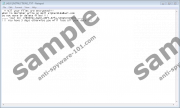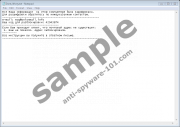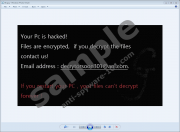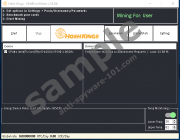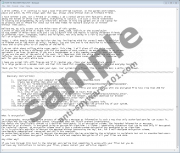A new variant of the Mole Ransomware has emerged, and it is called Mole66 Ransomware. The name coincides with the extension that is attached to the files that this infection encrypts. Unfortunately, it also encrypts the names of these files, which might make it impossible for you to figure out what was corrupted. Without a doubt, when you are faced with claims that your files were corrupted, the first thing you need to do is check if your files were in fact corrupted because there are so many infections that only pose as encryptors. Unfortunately, the threat we are discussing in this report definitely can corrupt your personal files, which might include photos and text documents. At the time of research, a free decryptor that could help you recover these files did not exist, but Anti-Spyware-101.com analysts are hopeful that it could be created in the future because other threats from the same group – including Mole03 Ransomware and Mole02 Ransomware – had decryptors. Unfortunately, right now, the only thing you can do is delete Mole66 Ransomware, and that is very important. Read more »
Trojans - Page 71 category archyve:
Gedantar Ransomware
If you suddenly face a window via which you are being introduced to Gedantar Ransomware, there is a possibility that your personal files have been encrypted. Our research team at Anti-Spyware-101.com has not found a fully-functional sample of this threat yet, and that is because it appears to be incomplete. Why did the creators unleash this half-finished infection? Most likely, they have not done it yet, but malware researchers have managed to unveil this threat. Unfortunately, it is impossible to say when – or if – this infection will be fully completed. Hopefully, it stays helpless forever, but we cannot count on that. Whether or not you have faced the threat, there are things you need to learn about it, including protection against it, and, of course, removal. We are hopeful that no one will need to worry about deleting Gedantar Ransomware from their Windows operating systems, but since we cannot predict that, removal instructions have been created to assist those in need. Read more »
Dont_worry Ransomware
Dont_worry Ransomware is a malicious application that was developed by cyber criminals. They create ransomware infections for only one purpose – they want to obtain money from people. This threat will not ask you kindly to send some money to its author. Instead, it tries to push users into sending money to cyber criminals by locking their pictures, music, and all other important files. Surprisingly, you will be told that you need to pay for the decryption service only after you write a message to the indicated email address. The majority of ransomware infections demand a ransom from users immediately after they lock files belonging to them. Since crypto-malware usually uses strong encryption algorithms to restrict access to users’ personal files, purchasing the decryptor from cyber criminals might be your only chance to unlock your data, but we still do not recommend sending money to the author of this threat. The reason why we say so is simple – we do not believe that you could unlock your files after paying the money required. Of course, you are the one who has to make the final decision in this case. Read more »
L0cked Ransomware
A malicious file-encrypting infection called L0cked Ransomware was discovered recently. Anti-Spyware-101.com research team has investigated it, and it appears that the threat has not been fully completed yet. Of course, it is also a possibility that it is a failed attempt at creating a fully functional file encryptor. Our research has revealed that the current version of the infection does not corrupt files; however, the threat can introduce victims to the demands anyway. Without a doubt, following them is not advised under any circumstances, and even if the malicious ransomware ends up encrypting every single personal file on your computer, following the instructions and paying the ransom is a terrible idea. Why? That is because the cyber criminals behind this infection have one thing on their mind, and that is your money. They can promise you anything just to get the money, and, unfortunately, they are unlikely to keep their promises once they do get it. In this report, we discuss the removal L0cked Ransomware, as well as ways to protect personal data and the operating system against malware in the future. Read more »
Miltipool Miner
With everyone being obsessed about the cryptocurrency nowadays, there are also many third-party applications out there designed to help people get the digital money. Miltipool Miner is one of those programs, and the reality is that it is a computer infection. The program is actually a mining program that makes use of a computer’s resources to “mine” cryptocurrency for its developers. If users fail to remove Miltipool Miner from their systems, they might eventually end up with extremely sluggish computers that cannot do anything at all. Therefore, the sooner you get rid of these types of threats, the better. Read more »
Whiterose Ransomware
Whiterose Ransomware is a threat that appends {random characters}_ENCRYPTED_BY.WHITEROSE extension to all files it enciphers. Later on, the malicious program is supposed to leave a ransom note claiming the user might get a decryption tool if he chats with its developers. Sadly, this is not all, since the ransom note also states the user would have to pay a ransom. The price is still unknown, although some users report the hackers asked around 0.2 BTC. Given there are no reassurances, these people will not try to scam users, so our researchers at Anti-spyware-101.com recommend not to put up with any demands and eliminate Whiterose Ransomware with the instructions located at the end of this article or a legitimate antimalware tool of your preference. However, if you wish to know more before deciding what to do, we invite you to keep reading our report, as further in the text we will discuss the malware’s possible distribution channels, its working manner, etc. Read more »
H34rtbl33d Ransomware
H34rtbl33d Ransomware is not a program that you want to find up and running on your operating system. If you ever discover this application active on your operating system, you must do everything in your power to remove it once and for all. Doing so is critical because this application is designed to encrypt massive quantities of data without any notification or authorization. As you can imagine, having a program capable of such functionality could lead to devastating outcomes, to put it lightly. In our article, we provide further information about the intricate inner workings of this malicious application. Also, we include a few virtual security recommendations that will help you maintain a clean and safe operating system at all times. Bellow, you will also find a comprehensive removal guide, which you should use to delete H34rtbl33d Ransomware without encountering any major problems. Read more »
Vurten Ransomware
Vurten Ransomware is a malicious computer infection that will encrypt your files with the intention to swindle you out of your money. It follows many other ransomware programs out there that have been all the rage for a few years now. You will have to remove Vurten Ransomware from your system, knowing that it might not be possible to retrieve your files.
However, ransomware programs seldom issue decryption keys even if users end up transferring the ransomware. Unless they are world-wide infections that get media coverage, it is very likely that they end up “dying” pretty soon. As a result, users would lose money for nothing. Read more »
Ladon Ransomware
Ladon Ransomware is a malware that marks its enciphered files with .ladon extension (e.g., panda.jpg.ladon). Provided your data have this specific extension, and you are seeing ransom notes asking you to pay for decryption tools, we strongly recommend reading the rest of this article. Further, in the report, we will discuss the malicious programs working manner, its distribution methods, risks of paying the ransom, how to restore files without the decryption tool, and other vital details. Moreover, at the end of this text, we will add instructions prepared by our researchers at Anti-spyware-101.com. They will show how you could eliminate Ladon Ransomware manually by deleting files belonging to it. Users who have more questions about removal or the threat itself can leave us comments below the article tool. Read more »
Avcrypt Ransomware
Avcrypt Ransomware is a threat that is meant to work primarily as a file encryptor, but our research team has found that it can do much more than that. If this threat slithers into your operating system, it can try to uninstall antivirus software using WMI command “cmd.exe /C wmic product where [AV VENDOR] call uninstall /nointeractive & shutdown /a & shutdown /a & shutdown /a.” Although our tests have shown that the threat could not successfully delete the antivirus tool that was used, we cannot guarantee that this function would fail every single time. Needless to say, if antivirus software is erased, stopping the malicious ransomware can be impossible, primarily because it is very quiet, and it encrypts files without alerting the victim. Needless to say, removing Avcrypt Ransomware is crucial, and even if it has encrypted your personal files, and you cannot recover them, you need to waste no more time with this malicious infection. Read more »
